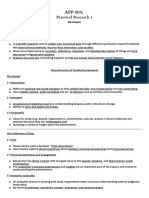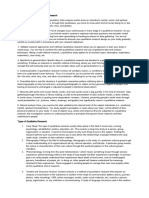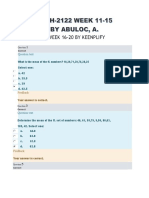Hinges - Google Search
Hinges - Google Search
Uploaded by
Maxwell DavorCopyright:
Available Formats
Hinges - Google Search
Hinges - Google Search
Uploaded by
Maxwell DavorCopyright
Available Formats
Share this document
Did you find this document useful?
Is this content inappropriate?
Copyright:
Available Formats
Hinges - Google Search
Hinges - Google Search
Uploaded by
Maxwell DavorCopyright:
Available Formats
Menu
Research Methodology » Research Design
Qualitative Vs
Quantitative Research
Methods & Data
Analysis
By Saul Mcleod, PhD Updated on June 2, 2023
Reviewed by Olivia Guy Evans
What is the difference between
quantitative and qualitative?
The main difference between quantitative and
qualitative research is the type of data they
collect and analyze.
Quantitative research collects numerical data
and analyzes it using statistical methods. The
aim is to produce objective, empirical data that
can be measured and expressed in numerical
terms. Quantitative research is often used to
test hypotheses, identify patterns, and make
predictions.
Qualitative research, on the other hand,
collects non-numerical data such as words,
images, and sounds. The focus is on exploring
subjective experiences, opinions, and attitudes,
often through observation and interviews.
Qualitative research aims to produce rich and
detailed descriptions of the phenomenon being
studied, and to uncover new insights and
meanings.
Quantitative data is information about
quantities, and therefore numbers, and
qualitative data is descriptive, and
regards phenomenon which can be
observed but not measured, such as
language.
Table of Contents
1. What Is Qualitative Research?
1. Qualitative Methods
2. Examples
3. Qualitative Data Analysis
4. Key Features
5. Limitations of Qualitative Research
6. Advantages of Qualitative Research
2. What Is Quantitative Research?
1. Quantitative Methods
2. Examples
3. Quantitative Data Analysis
4. Key Features
5. Limitations of Quantitative
Research
6. Advantages of Quantitative
Research
What Is Qualitative Research?
Qualitative research is the process of
collecting, analyzing, and interpreting non-
numerical data, such as language. Qualitative
research can be used to understand how an
individual subjectively perceives and gives
meaning to their social reality.
Qualitative data is non-numerical data, such as
text, video, photographs, or audio recordings.
This type of data can be collected using diary
accounts or in-depth interviews and analyzed
using grounded theory or thematic analysis.
Qualitative research is multimethod in
focus, involving an interpretive,
naturalistic approach to its subject
matter. This means that qualitative
researchers study things in their natural
settings, attempting to make sense of, or
interpret, phenomena in terms of the
meanings people bring to them.
Denzin and Lincoln (1994, p. 2)
Interest in qualitative data came about as the
result of the dissatisfaction of some
psychologists (e.g., Carl Rogers) with the
scientific study of psychologists such as
behaviorists (e.g., Skinner ).
Since psychologists study people, the
traditional approach to science is not seen as
an appropriate way of carrying out research
since it fails to capture the totality of human
experience and the essence of being human.
Exploring participants’ experiences is known
as a phenomenological approach (re:
Humanism ).
The aim of qualitative research is to
understand the social reality of individuals,
groups, and cultures as nearly as possible as its
participants feel it or live it. Thus, people and
groups are studied in their natural setting.
Research following a qualitative approach is
exploratory and seeks to explain ‘how’ and
‘why’ a particular phenomenon, or behavior,
operates as it does in a particular context. It
can be used to generate hypotheses and
theories from the data.
Qualitative Methods
There are different types of qualitative
research methods, including diary accounts,
in-depth interviews, documents, focus groups,
case study research, and ethnography.
The results of qualitative methods provide a
deep understanding of how people perceive
their social realities and in consequence, how
they act within the social world.
The researcher has several methods for
collecting empirical materials, ranging
from the interview to direct observation,
to the analysis of artifacts, documents,
and cultural records, to the use of visual
materials or personal experience.
Denzin and Lincoln (1994, p. 14)
Examples
Here are some examples of qualitative data:
1. Interview transcripts: Verbatim records
of what participants said during an interview
or focus group. They allow researchers to
identify common themes and patterns, and
draw conclusions based on the data.
Interview transcripts can also be useful in
providing direct quotes and examples to
support research findings.
2. Observations: The researcher typically
takes detailed notes on what they observe,
including any contextual information,
nonverbal cues, or other relevant details. The
resulting observational data can be analyzed
to gain insights into social phenomena, such
as human behavior, social interactions, and
cultural practices.
3. Unstructured interviews: generate
qualitative data through the use of open
questions. This allows the respondent to talk
in some depth, choosing their own words.
This helps the researcher develop a real
sense of a person’s understanding of a
situation.
4. Diaries or journals: Written accounts of
personal experiences or reflections.
Notice that qualitative data could be much
more than just words or text. Photographs,
videos, sound recordings, and so on, can be
considered qualitative data. Visual data can be
used to understand behaviors, environments,
and social interactions.
Qualitative Data Analysis
Qualitative research is endlessly creative and
interpretive. The researcher does not just leave
the field with mountains of empirical data and
then easily write up his or her findings.
Qualitative interpretations are constructed,
and various techniques can be used to make
sense of the data, such as content analysis,
grounded theory (Glaser & Strauss, 1967),
thematic analysis (Braun & Clarke, 2006), or
discourse analysis.
For example, thematic analysis is a qualitative
approach that involves identifying implicit or
explicit ideas within the data. Themes will
often emerge once the data has been coded.
Key Features
Events can be understood adequately only if
they are seen in context. Therefore, a
qualitative researcher immerses her/himself
in the field, in natural surroundings. The
contexts of inquiry are not contrived; they
are natural. Nothing is predefined or taken
for granted.
Qualitative researchers want those who are
studied to speak for themselves, to provide
their perspectives in words and other
actions. Therefore, qualitative research is an
interactive process in which the persons
studied teach the researcher about their
lives.
The qualitative researcher is an integral part
of the data; without the active participation
of the researcher, no data exists.
The study’s design evolves during the
research and can be adjusted or changed as
it progresses. For the qualitative researcher,
there is no single reality. It is subjective and
exists only in reference to the observer.
The theory is data-driven and emerges as
part of the research process, evolving from
the data as they are collected.
Limitations of Qualitative Research
Because of the time and costs involved,
qualitative designs do not generally draw
samples from large-scale data sets.
The problem of adequate validity or
reliability is a major criticism. Because of the
subjective nature of qualitative data and its
origin in single contexts, it is difficult to
apply conventional standards of reliability
and validity. For example, because of the
central role played by the researcher in the
generation of data, it is not possible to
replicate qualitative studies.
Also, contexts, situations, events, conditions,
and interactions cannot be replicated to any
extent, nor can generalizations be made to a
wider context than the one studied with
confidence.
The time required for data collection,
analysis, and interpretation is lengthy.
Analysis of qualitative data is difficult, and
expert knowledge of an area is necessary to
interpret qualitative data. Great care must be
taken when doing so, for example, looking
for mental illness symptoms.
Advantages of Qualitative Research
Because of close researcher involvement, the
researcher gains an insider’s view of the
field. This allows the researcher to find
issues that are often missed (such as
subtleties and complexities) by the scientific,
more positivistic inquiries.
Qualitative descriptions can be important in
suggesting possible relationships, causes,
effects, and dynamic processes.
Qualitative analysis allows for
ambiguities/contradictions in the data,
which reflect social reality (Denscombe,
2010).
Qualitative research uses a descriptive,
narrative style; this research might be of
particular benefit to the practitioner as she
or he could turn to qualitative reports to
examine forms of knowledge that might
otherwise be unavailable, thereby gaining
new insight.
What Is Quantitative
Research?
Quantitative research involves the process of
objectively collecting and analyzing numerical
data to describe, predict, or control variables of
interest.
The goals of quantitative research are to test
causal relationships between variables, make
predictions, and generalize results to wider
populations.
Quantitative researchers aim to establish
general laws of behavior and phenomenon
across different settings/contexts. Research is
used to test a theory and ultimately support or
reject it.
Quantitative Methods
Experiments typically yield quantitative data,
as they are concerned with measuring things.
However, other research methods, such as
controlled observations and questionnaires,
can produce both quantitative information.
For example, a rating scale or closed questions
on a questionnaire would generate quantitative
data as these produce either numerical data or
data that can be put into categories (e.g., “yes,”
“no” answers).
Experimental methods limit how a research
participant can react to and express
appropriate social behavior.
Findings are, therefore, likely to be context-
bound and simply a reflection of the
assumptions that the researcher brings to the
investigation.
Examples
There are numerous examples of quantitative
data in psychological research, including
mental health. Here are a few examples:
1. Standardized psychological
assessments: One example of a
standardized psychological assessment of IQ
that uses quantitative data is the Wechsler
Adult Intelligence Scale (WAIS).
Another example is the Experience in Close
Relationships Scale (ECR), a self-report
questionnaire widely used to assess adult
attachment styles.
The ECR provides quantitative data that can
be used to assess attachment styles and
predict relationship outcomes.
2. Neuroimaging data: Neuroimaging
techniques, such as MRI and fMRI, provide
quantitative data on brain structure and
function.
This data can be analyzed to identify brain
regions involved in specific mental processes
or disorders.
3. Clinical outcome measures: The use of
clinical outcome measures provides
objective, standardized data that can be used
to assess treatment effectiveness and
monitor symptoms over time, helping
mental health professionals make informed
decisions about treatment and care.
For example, the Beck Depression Inventory
(BDI) is a clinician-administered
questionnaire widely used to assess the
severity of depressive symptoms in
individuals.
The BDI consists of 21 questions, each
scored on a scale of 0 to 3, with higher scores
indicating more severe depressive
symptoms.
Quantitative Data Analysis
Statistics help us turn quantitative data into
useful information to help with decision-
making. We can use statistics to summarize
our data, describing patterns, relationships,
and connections. Statistics can be descriptive
or inferential.
Descriptive statistics help us to summarize our
data. In contrast, inferential statistics are used
to identify statistically significant differences
between groups of data (such as intervention
and control groups in a randomized control
study).
Key Features
Quantitative researchers try to control
extraneous variables by conducting their
studies in the lab.
The research aims for objectivity (i.e.,
without bias) and is separated from the data.
The design of the study is determined before
it begins.
For the quantitative researcher, the reality is
objective, exists separately from the
researcher, and can be seen by anyone.
Research is used to test a theory and
ultimately support or reject it.
Limitations of Quantitative Research
Context: Quantitative experiments do not
take place in natural settings. In addition,
they do not allow participants to explain
their choices or the meaning of the questions
they may have for those participants (Carr,
1994).
Researcher expertise: Poor knowledge of the
application of statistical analysis may
negatively affect analysis and subsequent
interpretation (Black, 1999).
Variability of data quantity: Large sample
sizes are needed for more accurate analysis.
Small-scale quantitative studies may be less
reliable because of the low quantity of data
(Denscombe, 2010). This also affects the
ability to generalize study findings to wider
populations.
Confirmation bias: The researcher might
miss observing phenomena because of focus
on theory or hypothesis testing rather than
on the theory of hypothesis generation.
Advantages of Quantitative
Research
Scientific objectivity: Quantitative data can
be interpreted with statistical analysis, and
since statistics are based on the principles of
mathematics, the quantitative approach is
viewed as scientifically objective and rational
(Carr, 1994; Denscombe, 2010).
Useful for testing and validating already
constructed theories.
Rapid analysis: Sophisticated software
removes much of the need for prolonged
data analysis, especially with large volumes
of data involved (Antonius, 2003).
Replication: Quantitative data is based on
measured values and can be checked by
others because numerical data is less open to
ambiguities of interpretation.
Hypotheses can also be tested because of
statistical analysis (Antonius, 2003).
References
Antonius, R. (2003). Interpreting quantitative
data with SPSS. Sage.
Black, T. R. (1999). Doing quantitative
research in the social sciences: An integrated
approach to research design, measurement
and statistics. Sage.
Braun, V. & Clarke, V. (2006). Using thematic
analysis in psychology. Qualitative Research in
Psychology, 3, 77–101.
Carr, L. T. (1994). The strengths and
weaknesses of quantitative and qualitative
research: what method for nursing? Journal of
advanced nursing, 20(4), 716-721.
Denscombe, M. (2010). The Good Research
Guide: for small-scale social research.
McGraw Hill.
Denzin, N., & Lincoln. Y. (1994). Handbook of
Qualitative Research. Thousand Oaks, CA, US:
Sage Publications Inc.
Glaser, B. G., Strauss, A. L., & Strutzel, E.
(1968). The discovery of grounded theory;
strategies for qualitative research. Nursing
research, 17(4), 364.
Minichiello, V. (1990). In-Depth Interviewing:
Researching People. Longman Cheshire.
You might also like
- Ucc Thesis Format LatestDocument17 pagesUcc Thesis Format LatestJf AnisetoNo ratings yet
- Qualitative RafuDocument44 pagesQualitative Rafually jumanneNo ratings yet
- Qualitative Research DesignDocument35 pagesQualitative Research Designkimemia100% (5)
- Characteristics and Types of Qualitative ResearchDocument2 pagesCharacteristics and Types of Qualitative ResearchMark Vincent Fernandez100% (11)
- Research Methods PA 603: Public Administration Department Yarmouk UniversityDocument33 pagesResearch Methods PA 603: Public Administration Department Yarmouk Universityحسينالربابعه100% (1)
- What's The Difference Between Qualitative and Quantitative Research?Document9 pagesWhat's The Difference Between Qualitative and Quantitative Research?MaryJoyceRamosNo ratings yet
- Qualitative & QuantitativeDocument6 pagesQualitative & QuantitativeERICKA GRACE DA SILVANo ratings yet
- Why Choose QualitativeDocument9 pagesWhy Choose QualitativeAngelo VillafrancaNo ratings yet
- Qualitative vs. Quantitative ResearchDocument6 pagesQualitative vs. Quantitative ResearchChristia Abdel HayNo ratings yet
- App 005: Practical Research 1Document10 pagesApp 005: Practical Research 1ayannazxiNo ratings yet
- Qualitative Vs Quantitative ResearchDocument67 pagesQualitative Vs Quantitative ResearchAlano Jo100% (3)
- Chapter 3 Quantitative Qualitative Research DesignDocument5 pagesChapter 3 Quantitative Qualitative Research DesignBenjie HallardaNo ratings yet
- Qualitative Research An IntroductionDocument43 pagesQualitative Research An Introductionmary car fabularumNo ratings yet
- Practical Research 1 SlideshowDocument96 pagesPractical Research 1 SlideshowGresel GabawanNo ratings yet
- 6 - Designing Qualitative ResearchDocument39 pages6 - Designing Qualitative Researchawokegoshi100% (1)
- 3Q Activity 2Document2 pages3Q Activity 2YZAH LORRAINE DELA CRUZNo ratings yet
- Characteristics of Qualitative ResearchDocument5 pagesCharacteristics of Qualitative Researchshabnam100% (1)
- Introduction To Qualitative Research: Japhet E. ManzanoDocument32 pagesIntroduction To Qualitative Research: Japhet E. ManzanoMauie Uy JonasNo ratings yet
- PR1 Lesson 3Document7 pagesPR1 Lesson 3Ruel AcostaNo ratings yet
- Week 2 q3Document16 pagesWeek 2 q3catherine saldeviaNo ratings yet
- Methodology BSDocument11 pagesMethodology BSliyanayanaa96No ratings yet
- PR1 L4Document43 pagesPR1 L4Garie PanganibanNo ratings yet
- Qualitative ResearchDocument17 pagesQualitative ResearchNouvie AguirreNo ratings yet
- Sociology AssignmentDocument7 pagesSociology Assignmentakhilaajith420No ratings yet
- Assignment 1-2 - Quantitative and Qualitative ResearchDocument11 pagesAssignment 1-2 - Quantitative and Qualitative ResearchBenedict Arman TanchaucoNo ratings yet
- Q3 Week1 Part2Document35 pagesQ3 Week1 Part2Mary Rose AlegriaNo ratings yet
- Characteristics of A Qualitative ResearchDocument3 pagesCharacteristics of A Qualitative ResearchMARICEL CAINGLESNo ratings yet
- COMMDocument6 pagesCOMMricellenekaterenegado0No ratings yet
- 4 Characteristics and Kinds of Qualitative ResearchDocument17 pages4 Characteristics and Kinds of Qualitative ResearchmaygracedigolNo ratings yet
- Unit 2 Qualitative Research 1. The Nature of Qualitative ResearchDocument77 pagesUnit 2 Qualitative Research 1. The Nature of Qualitative ResearchArchana PokharelNo ratings yet
- Fakhri FikriDocument4 pagesFakhri FikrifakhriNo ratings yet
- Ce - ch14 Qualitative Research1Document16 pagesCe - ch14 Qualitative Research1faul ahmad100% (1)
- Pr1 ReviewerDocument19 pagesPr1 ReviewerLuke Pinon HornillaNo ratings yet
- Practical Research 2.3Document8 pagesPractical Research 2.3Michael GabertanNo ratings yet
- What Is Qualitative Research? - Methods & ExamplesDocument5 pagesWhat Is Qualitative Research? - Methods & ExamplesHridya sNo ratings yet
- PR1 Qualitative ResearchDocument3 pagesPR1 Qualitative ResearchBlackLotus D. GreatNo ratings yet
- Comparative Research ParadigmsDocument10 pagesComparative Research Paradigmstozion01No ratings yet
- Qualitative ResearchDocument4 pagesQualitative ResearchjanellepamelaNo ratings yet
- Qualitative Research ForDocument46 pagesQualitative Research ForThanavathi100% (1)
- Chapter 5 Qualitative ResearchDocument30 pagesChapter 5 Qualitative Researchkamleshmisra22No ratings yet
- Practical Research Lesson 2Document25 pagesPractical Research Lesson 2Lance Go LlanesNo ratings yet
- Lesson 3 QUALITATIVE-RESEARCHDocument22 pagesLesson 3 QUALITATIVE-RESEARCHvyn bringinoNo ratings yet
- Pradigms and Characteristics of A Good Qualitative ResearchDocument14 pagesPradigms and Characteristics of A Good Qualitative ResearchRhe Rhe AmeliaNo ratings yet
- how-to-develop-research-methodologyDocument36 pageshow-to-develop-research-methodologychavezkayjasminrechNo ratings yet
- WWW - Gifted.uconn - Edu Siegle Research Qualitative Qualquan - HTMDocument4 pagesWWW - Gifted.uconn - Edu Siegle Research Qualitative Qualquan - HTMFran AlliesNo ratings yet
- Week2Q3 LAS PracticalResearch1 FinalDocument8 pagesWeek2Q3 LAS PracticalResearch1 FinalLaurice GomezNo ratings yet
- PR1 Hand Out No. 2Document3 pagesPR1 Hand Out No. 2kyyzelleezapantaaNo ratings yet
- Research 1 Module4Document26 pagesResearch 1 Module4Christine LopenaNo ratings yet
- ResearchDocument5 pagesResearchJonas CabusbusanNo ratings yet
- III. Qualitative ResearchDocument127 pagesIII. Qualitative ResearchMayeyean TaguibalosNo ratings yet
- Ethics in ResearchDocument6 pagesEthics in ResearchGlad FeriaNo ratings yet
- Qualitative ResearchDocument20 pagesQualitative ResearchJv Loo Caguioa100% (1)
- Qualitative Research in NursingDocument98 pagesQualitative Research in NursingMark Anthony Flores75% (8)
- NOTES.MODULE-3.A-CLOSER-LOOK-ON-QUALITATIVE-RESEARCHDocument3 pagesNOTES.MODULE-3.A-CLOSER-LOOK-ON-QUALITATIVE-RESEARCHDuran CjNo ratings yet
- DM - RDL 1 - Module 3Document17 pagesDM - RDL 1 - Module 3Mark100% (1)
- DISCUSSION 2 Qualitative ResearchDocument34 pagesDISCUSSION 2 Qualitative ResearchDave BanquerigoNo ratings yet
- Business Research MethodologyDocument13 pagesBusiness Research Methodologyjavindersheokand456No ratings yet
- Research & StatisticsDocument12 pagesResearch & StatisticsLeigh FerrerNo ratings yet
- Scope of qualitative researchDocument6 pagesScope of qualitative researchmartinsNo ratings yet
- Qualitative ResearchDocument30 pagesQualitative ResearchUbaidullah KhanNo ratings yet
- All Resumes of All Qualitative MaterialsDocument10 pagesAll Resumes of All Qualitative MaterialsSH TMNo ratings yet
- Www-Researchgate-Net-Publication-354306611 Value Stream Mapping For Knowledge WoDocument10 pagesWww-Researchgate-Net-Publication-354306611 Value Stream Mapping For Knowledge WoUma KANo ratings yet
- Research Approaches TypesDocument18 pagesResearch Approaches TypesSinelizwi BambuleNo ratings yet
- Decolonising Afrikan Masculinities TowarDocument229 pagesDecolonising Afrikan Masculinities Towarnewman mapfumoNo ratings yet
- Pengantar Statistik Industri: Debrina Puspita Andriani E-MailDocument40 pagesPengantar Statistik Industri: Debrina Puspita Andriani E-MailyogiNo ratings yet
- Stealing and Academic AchievementDocument32 pagesStealing and Academic AchievementtesiranlimitedNo ratings yet
- 2024 Index Methodology Final-1696932306Document54 pages2024 Index Methodology Final-1696932306abdulalemalnsefNo ratings yet
- JURNALDocument10 pagesJURNALkhairulNo ratings yet
- Chapter 9Document9 pagesChapter 9fitsebigNo ratings yet
- Developmental Research Methods Creating Knowledge PDFDocument17 pagesDevelopmental Research Methods Creating Knowledge PDFJhasper ManagyoNo ratings yet
- Introduction To Survey Methodology and Sampling Techniques (PDFDrive)Document1,046 pagesIntroduction To Survey Methodology and Sampling Techniques (PDFDrive)amien_ptkNo ratings yet
- Narrative ReportDocument3 pagesNarrative ReportCharmaine AsongNo ratings yet
- Games Design DissertationDocument8 pagesGames Design DissertationWhatShouldIWriteMyPaperOnColoradoSprings100% (1)
- Wa0000. 11 12Document2 pagesWa0000. 11 12sayalibarhate2717No ratings yet
- Esp ReviewerDocument6 pagesEsp ReviewerAltea Kyle CortezNo ratings yet
- Topic 2 Research DesignDocument49 pagesTopic 2 Research DesignNOOR ARFARINA BINTI NASIR (BP)No ratings yet
- Metaphysics and The SciencesDocument78 pagesMetaphysics and The SciencesV KNo ratings yet
- Operational Research Mid Sem 1 PaperDocument3 pagesOperational Research Mid Sem 1 Paperasif ansariNo ratings yet
- 1.3 Compare Experimental and Theoretical ProbabilityDocument14 pages1.3 Compare Experimental and Theoretical ProbabilityGaganpreet KaurNo ratings yet
- INSAG 25 A Framework For An Integrated Risk Informed Decision MakingDocument39 pagesINSAG 25 A Framework For An Integrated Risk Informed Decision MakingAhmed RahmanNo ratings yet
- Question 4 Explanation FileDocument3 pagesQuestion 4 Explanation FileSarange FortuneNo ratings yet
- Faculty Evaluation Chap IIIDocument3 pagesFaculty Evaluation Chap IIIQuezon Medical Center Administrative OfficeNo ratings yet
- 3i's - 4th Quarter ReviewerDocument5 pages3i's - 4th Quarter ReviewerPaper RubinNo ratings yet
- 2015-16 Science Fair RubricDocument2 pages2015-16 Science Fair Rubricapi-287137309No ratings yet
- THREE - 4665-Research Methods-IDocument6 pagesTHREE - 4665-Research Methods-IsaifurrNo ratings yet
- Interpretation and Statistical Inference With OLS RegressionsDocument17 pagesInterpretation and Statistical Inference With OLS RegressionsXènia Bellet NavarroNo ratings yet
- RSCH-2122 WEEK 11-20 - Abuloc, A. + KeenplifyDocument9 pagesRSCH-2122 WEEK 11-20 - Abuloc, A. + KeenplifyAngelica Mae TibayanNo ratings yet
- Human FlourishingDocument4 pagesHuman FlourishingDelola Cabalan Eddie Jr.50% (2)
- Ar Loc Addis Ababa's Sefer, Iddir, and Gebbi Anteneh TDocument330 pagesAr Loc Addis Ababa's Sefer, Iddir, and Gebbi Anteneh Talexdariocabrera992No ratings yet

























































































